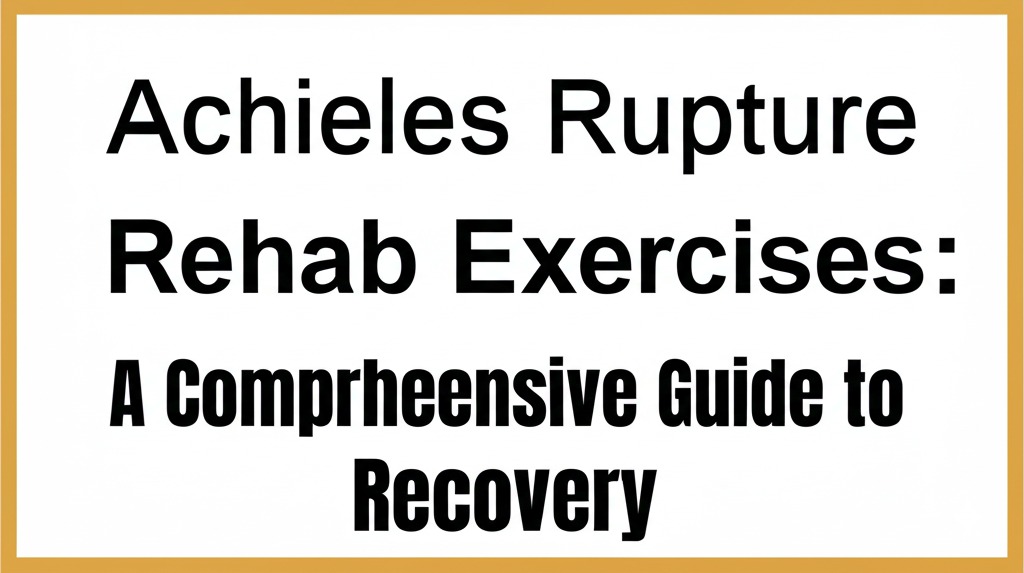An Achilles tendon rupture is a serious injury that can significantly impact your mobility and daily activities. If you’re recovering from an Achilles rupture, it’s important to follow a structured rehabilitation program to regain strength, flexibility, and function. This article will guide you through the essential rehab exercises you need to incorporate into your recovery process, helping you return to an active lifestyle.
What Is Achilles Rupture and How Is It Treated?
An Achilles tendon rupture occurs when the tendon that connects the calf muscles to the heel bone tears, often due to sudden intense movement, overuse, or trauma. This injury typically results in severe pain, swelling, and difficulty walking. In some cases, surgery may be required to repair the rupture, but most people can recover with a combination of rest, physical therapy, and specific rehabilitation exercises.
Why Rehabilitation Is Key to Recovery
Rehabilitation (rehab) is essential for healing after an Achilles rupture. Without proper rehabilitation, you risk losing strength, flexibility, and coordination in the injured leg, which can lead to long-term complications. Rehab exercises help:
- Strengthen the calf muscles and Achilles tendon
- Improve mobility and flexibility
- Reduce the risk of re-injury
- Restore balance and coordination for functional movement
Essential Achilles Rupture Rehab Exercises
Rehabilitation exercises for Achilles rupture recovery should be gradually introduced to avoid overloading the tendon. Always consult with a healthcare professional before starting any new exercise program. Below are the key exercises to include in your rehab routine.
1. Calf Stretching Exercises
Stretching the calf muscles and Achilles tendon is vital to restore flexibility and prevent stiffness. Start with gentle stretching, and gradually increase intensity.
Standing Calf Stretch
- Stand facing a wall with one foot forward and the other foot back.
- Keep your back leg straight and your heel on the floor.
- Lean forward, bending your front knee and pressing your hips toward the wall.
- Hold the stretch for 30 seconds, repeat 3 times per leg.
Seated Calf Stretch
- Sit on the floor with your injured leg extended.
- Loop a towel around the ball of your foot and gently pull your toes toward your shin.
- Hold the stretch for 30 seconds, repeat 3 times per leg.
2. Eccentric Heel Drops
Eccentric exercises are crucial for rebuilding strength and tendon resilience after an Achilles rupture. This exercise targets the calf muscles and helps to safely load the Achilles tendon.
- Stand on a step with the balls of both feet, heels hanging off the edge.
- Raise both heels by pushing through the balls of your feet.
- Slowly lower one heel at a time, allowing the injured leg to drop lower than the non-injured leg.
- Perform 2-3 sets of 10-15 repetitions.
3. Heel and Toe Raises
Heel and toe raises are simple yet effective for rebuilding strength in the calf and Achilles tendon.
- Stand with your feet flat on the ground, hip-width apart.
- Slowly raise both heels off the ground, balancing on the balls of your feet.
- Lower your heels back down and then raise your toes (toes-only raise) to work the opposite muscles.
- Perform 2-3 sets of 10-15 repetitions.
4. Resisted Ankle Dorsiflexion
This exercise targets the muscles that help with ankle movement and stability.
- Sit on the floor with your legs extended.
- Loop a resistance band around your foot and anchor it to a stationary object.
- Slowly pull your foot toward you against the resistance of the band.
- Perform 2-3 sets of 10-12 repetitions per foot.
5. Balance and Proprioception Exercises
Rebuilding balance and proprioception is essential for improving coordination and preventing future injury.
Single-Leg Stance
- Stand on one leg for 30 seconds to 1 minute, maintaining your balance.
- Increase difficulty by standing on an unstable surface like a balance pad or foam cushion.
- Repeat 3 times per leg.
6. Treadmill Walking or Pool Walking
Once you’ve regained some strength and flexibility, walking can help improve your gait and restore function to your leg.
- Start by walking on a treadmill with a slight incline to ease the load on your tendon.
- Pool walking is a low-impact alternative that offers the benefits of walking with less strain on your body.
How to Progress Your Rehab
As you progress in your rehabilitation, gradually increase the intensity and complexity of the exercises. After the initial phases of recovery, your physical therapist may introduce more advanced exercises such as:
- Jogging or running drills
- Plyometric exercises (jumping and landing drills)
- Functional movements (e.g., squats, lunges)
Tips for a Successful Rehab Journey
- Listen to your body: Pain should not be a part of your rehabilitation exercises. If you feel sharp or intense pain, stop immediately and consult your doctor.
- Consistency is key: Regular exercise is essential for long-term recovery. Stick to your rehab schedule.
- Incorporate rest: Ensure you are balancing exercise with proper rest to prevent overloading the tendon.
Conclusion
Recovering from an Achilles tendon rupture is a gradual process, but with the right rehab exercises, you can regain strength, flexibility, and mobility. Focus on calf stretches, eccentric heel drops, strengthening exercises, and balance drills to facilitate a full recovery. Always consult with your healthcare provider or physical therapist before starting any new exercises to ensure you are on the right track.
If you’re ready to start your rehab journey or need professional guidance, consult with a physical therapist who can help tailor an exercise plan specifically for you. Don’t wait—take the first step towards a stronger, healthier you!
4o mini

Kallie Snyder is an author at Stonegate Health Rehab, providing valuable insights, recovery guidance, and rehab resources to help individuals achieve better health and well-being.
